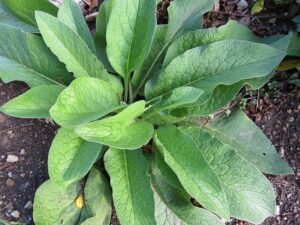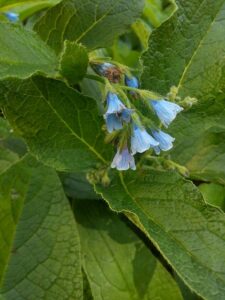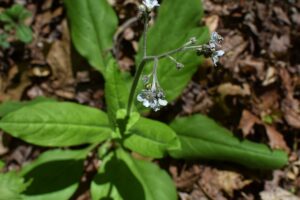Growing Comfrey
Comfrey is considered a star plant in permaculture circles because of it’s many uses. Learn how to grow comfrey and use in your garden.

Choosing the Right Comfrey Plant
When selecting a comfrey plant, the two popular variants you’ll encounter are the common comfrey (Symphytum officinale) and Russian comfrey (Symphytum x uplandicum). The choice between the two depends largely on your gardening goals.
Common comfrey(Symphytum officinale) is often favored for its medicinal properties and self-seeds prolifically. The ‘Bocking 14’ (Symphytum x uplandicum ‘Bocking 14’) is a cultivar of Russian comfrey, appreciated for its high potash content, making it an excellent choice for use as a natural fertilizer. Unlike other comfrey varieties, ‘Bocking 14’ does not self-seed, hence controlling its spread is easier.
Dwarf Comfrey
Dwarf comfrey (Symphytum ibericum), as the name suggests, is a smaller plant, reaching only about a foot in height. It’s an excellent ground cover and often chosen for ornamental purposes due to its attractive springtime flowers.
Comfrey x Uplandicum
A hybrid variant, the Comfrey x uplandicum, merges the best traits of its parent plants – the common comfrey and the prickly comfrey. It exhibits a robust growth habit and is known for its high yield, which is especially beneficial if you’re interested in creating a significant amount of biomass. This variant is also favored for its resilience, being able to thrive in a variety of soil conditions. However, unlike the ‘Bocking 14’ comfrey, Comfrey x uplandicum is capable of self-seeding, which can lead to it becoming invasive in some conditions. It’s essential to regularly monitor and manage the growth of Comfrey x uplandicum in the garden to prevent it from taking over.
Comfrey Grandiflorum
Another variety worth mentioning is the comfrey grandiflorum (Symphytum grandiflorum). This type of comfrey is particularly known for its ornamental value. It boasts large, distinctive flowers, usually white or pale yellow, that add a striking aesthetic appeal to any garden. Despite being smaller in stature compared to other comfrey types, typically reaching heights of one to two feet, Comfrey grandiflorum is a hardy plant. It performs well in a variety of soil types and prefers partial shade to full sun. However, unlike its counterparts, it does not produce as much biomass, thus may not be your first choice if you’re seeking to generate a large volume of compost.
Preparing the Soil

Comfrey boasts an affinity for rich, well-drained soil, which it needs to reach its full potential. If your soil is lacking in nutrients or does not drain well, it’s recommended to amend it with organic matter. Organic compost, aged manure, or leaf mold will not only enrich the soil with key nutrients but will also improve its structure and drainage. Start by loosening the existing soil with a garden fork or tiller, then mix in the organic matter to create a fertile bed where your comfrey plants will thrive.
Planting Comfrey
Planting comfrey involves using root cuttings, which can be obtained from mature comfrey plants. These root sections, which should ideally be about 2 inches in length, are to be planted horizontally in your prepared soil. Ensure each cutting is buried approximately 2 inches deep in the soil. This depth is essential as it provides the cutting with enough cover to establish itself while protecting it from being dislodged by weather elements or activity on the surface.
When spacing out your comfrey plants, maintain a gap of at least 3 feet between each plant. This allows each plant ample space to develop its sizable taproot system and leafy growth without competition for nutrients and sunlight. Remember, comfrey plants can grow to be quite large, so providing sufficient room for growth is key to a healthy and productive comfrey patch.
Comfrey’s Invasive Nature

Despite its myriad benefits, comfrey has an invasive nature. Comfrey’s robust growth can quickly take over your garden if not properly managed. This propensity for rapid proliferation largely stems from its resilient root system and in any cultivar but blocking 14 the prolific self-seeding. Even the smallest fragment of comfrey root can give rise to a new plant, making it incredibly difficult to fully eradicate once established. This trait, while advantageous in terms of propagating the plant, can cause problems for gardeners who find comfrey infringing on the space of other plants. Therefore, if you plan to include comfrey in your garden, consider its invasive nature and take necessary precautions to control its spread. Implementing strategies such as planting in contained areas or regular pruning can help manage comfrey’s growth and prevent it from becoming a garden bully.
This very characteristic is what makes it so useful in permaculture situations where large amounts of biomass are wanted to increase soil fertility. If your plan is chop and drop mulch and fertilizing comfreys invasive nature won’t be an issue.
Carrying Out Regular Maintenance
After the comfrey plants are established, it’s crucial to ensure they receive regular watering, especially during dry spells. While comfrey is hardy and capable of withstanding periods of drought once mature, young plants will need consistent moisture to develop their extensive root systems.
As for pest control, one of the advantages of growing comfrey is its inherent pest resistance. Most people consider comfrey a weed in need of eradication. Typically, comfrey plants are not appealing to many common garden pests.
Pruning Comfrey
Pruning comfrey plants is an important part of their maintenance. Pruning doesn’t just keep the plants in check; it also helps to stimulate new growth, leading to more lush and vibrant foliage. To prune your comfrey, simply cut back the entire plant to ground level, removing all of the leaves and stems. This should be done every time the plant reaches about 2 feet in height, or whenever you notice the leaves starting to yellow or wilt. Don’t worry it will come back again and again.
Remember to be cautious while pruning, as comfrey can have prickly hairs that may cause skin irritation. Always wear gloves and use sharp, clean tools to make the cuts. The leaves and stems you cut off can be used directly as mulch on your garden beds, or composted to create a rich soil amendment.

Propagating Comfrey
Comfrey propagation is generally achieved through root division in early spring or late autumn. To divide the plant, simply dig around the base of an established comfrey plant to expose its root system. Carefully cut away a section of the root, ensuring there is at least one eye (bud) present. This root section can then be planted in a prepared hole horizontally and approximately two inches deep, with the eye facing upwards. The root should be covered with soil and firmly pressed down. Ensure the newly planted comfrey is adequately watered. Over a period of a few weeks, new growth should start to emerge. Remember, each piece of root has the potential to develop into a new plant, so use caution to avoid unintentional spread.
While Blocking 14 comfrey does not self-seed, all other cultivars do. If you don’t want your comfrey to pop up everywhere cut off the seed heads before they have a chance to spread.
If you are planting comfrey seeds keep in mind they need winter chilling to germinate so may not come up until the following year and sometimes even two years. In general, it’s easier to propagate by root cuttings.
If you look around your yard or property, you likely have comfrey growing already. Maybe more than you’d like!
Using Comfrey in Gardening
Comfrey As a Green Manure or Mulch
Comfrey leaves break down rapidly, enriching the soil with essential nutrients. By using the leaves as a green manure or mulch, it can greatly improve the fertility of your garden soil. To do so, simply cut the leaves from your comfrey plant and lay them out directly onto your garden beds. As the leaves decompose, they naturally release a wealth of nutrients including nitrogen, phosphorus, and potassium, all of which boost plant growth and health. This process can be particularly beneficial for nutrient-hungry crops, providing them with the essential sustenance they require to thrive. Additionally, using comfrey leaves as mulch helps retain soil moisture and suppress the growth of weeds, further contributing to a robust and vibrant garden.
Making Comfrey Tea for Your Garden
Comfrey tea serves as a potent, nutrient-rich liquid fertilizer for your plants. To make this ‘tea’, begin by submerging comfrey leaves in a container of water. Over time, these leaves will decompose and create a rich, nutrient-dense liquid. This process requires patience, as it often takes several weeks for the leaves to fully break down. Once the tea is ready, you can dilute it with water (typically a 10:1 ratio of water to tea is recommended) and apply it directly to the soil around your plants. The high nutrient content in comfrey tea, particularly in nitrogen, phosphorus, and potassium, helps promote robust plant growth and health. It’s an organic, cost-effective means of nourishing your garden and leveraging the full potential of your comfrey plants.
Composting with Comfrey
The benefits of comfrey extend beyond making tea for plants; it can also play a significant role in your compost pile. Comfrey leaves decompose at an impressive speed, which helps accelerate the composting process and promotes the efficient break-down of other materials in the pile. To utilize comfrey in your compost, simply add the leaves to your compost pile or bin. As they decompose, they’ll not only expedite the overall composting process but also enrich the compost with their nutrient content. This makes your final compost product even more beneficial for your garden, providing a holistic, organic means of boosting plant health and growth. Composting with comfrey, therefore, offers a valuable method of recycling garden waste while enhancing the quality of your soil.
Comfrey as a Companion Plant
Comfrey’s deep-reaching roots make it an ideal companion plant, particularly for fruit trees and other deep-rooted plants. These roots delve far into the soil, drawing up essential nutrients from depths that other plants cannot reach. Planted near fruit trees or other crops, the comfrey can effectively mine these nutrients and bring them closer to the soil surface. As the comfrey leaves fall and decompose, they release these nutrients back into the topsoil, enriching it and making essential minerals more accessible for neighboring plants. This characteristic makes comfrey a valuable player in any permaculture system or organic garden, promoting nutrient cycling and improving soil fertility naturally and sustainably.
Conclusion
Comfrey is an incredibly versatile plant, offering a range of uses in the garden from composting to mulch and beyond. With its deep-reaching roots and impressive nutrient content, comfrey can be used to make your garden more fertile.
If you are interested in Comfrey medicinal uses check out my article here.

